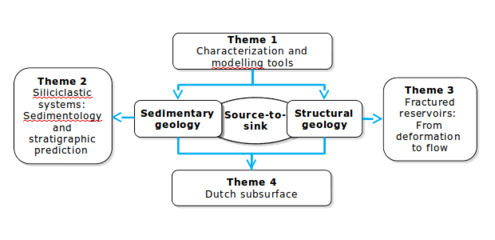Research
The use of the shallow and deep subsurface is becoming increasingly intensive as worldwide growing welfare presses for more and better natural resources. Subsurface layers are characterised by multi-scale sedimentological and structural heterogeneities. Detailed predictions of their geometry, physical properties and mechanic and flow behaviour are key for an effective and responsible resource exploration and exploitation.
Focussing on subsurface sedimentary bodies that host natural resources such as hydrocarbons, groundwater and geothermal energy, but that also represent potential CO2 storage sites, the mission of the Geology unit is to:
Develop knowledge and tools to qualify and predict the multi-scale architecture, the physical properties of sedimentary bodies in the subsurface – including their uncertainties - and their flow and geomechanical behaviour.
Subsurface data have to be gathered which includes seismic data, cores, well logs, data from production history. A vast array of new reservoir characterization techniques has been developed in the last decade, such a borehole imaging, nuclear magnetic resonance and spectroscopy methods, downhole seismic imaging in real time, and sophisticated directional drilling methods.
The Geology unit aims to achieve better quantitative 3D geological models of the sedimentary architecture of the subsurface on reservoir scale beyond seismic resolution. The novel geological modelling techniques we are developing will enable us to distinguish flow units and to quantify the geometry and connectivity of the subsurface as precisely as possible. The combination of geological and engineering sciences is uncommon in the landschape of research organisations.
The Geology unit chooses explicitly a multidisciplinary approach that encompasses sedimentological and structural research themes. In line with this choice, we divide the research programme into four interconnecting themes. These are:

Key in the overall strategy of the unit is a powerful combination of observation, mostly of recent and outcropping fossil sediments, and process-based modelling. Outcrops provide invaluable information on the end-result of natural sedimentological and structural processes. Process-based models allow for the phenomenological understanding of how these end-products have been obtained and, thereby, allow extrapolation in uncovered spatial and temporal domains.